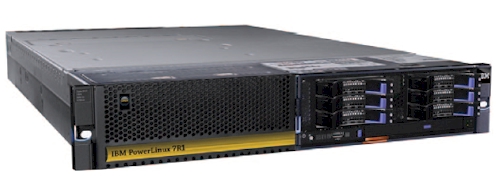This article is more than 1 year old
IBM lets fly single-socket Power7 Penguin server
Yellow stripe, big price cut, Linux only
Big Blue has launched a third Power-powered Penguin box and pitched it against x86 server rivals.
The machine, called the PowerLinux 7R1, is a single-socket machine that complements the two-socket PowerLinux 7R2 rack and tower server, and the Flex System p24L half-width node for PureSystem modular servers.
Back in April IBM revived its Linux-only variant of Power Systems servers, which are significantly cheaper than the vanilla boxes that run IBM's own AIX or IBM i (formerly OS/400) operating systems in addition to Linux.
The PowerLinux machines also sport a dramatically reduced PowerVM hypervisor, and the combination of cheap iron and a cheap hypervisor makes them competitive against virtualised x86 iron using VMware's ESXi hypervisor and vSphere management stack.
IBM is not crazy enough to think it can take on the x86 server with cheaper Power machines and still keep its revenue stream and profits. Rather, the idea is to pick specific workloads, like Hadoop data munchers and various HPC workloads as well as SAP application stacks, among a few others, and provide a Power server that is hardcoded to only run Red Hat Enterprise Linux 6 or SUSE Linux Enterprise Server 11 SP1 and therefore does not degrade AIX and IBM i server sales.
The deeper price cuts may annoy AIX and IBM i shops, of course, and they may demand similar pricing; provided they are important enough, they just might get it. But probably not.
Compare the price tags
The differences in component prices are worth kicking up a fuss about. Take the Power 730 vanilla server and the PowerLinux 7R2 machine that it is based upon. The base server iron using two eight-core 3.55GHz Power7 processors costs 18.8 per cent less when the yellow stripe and PowerLinux label is slapped on it.
Disk drive prices are somewhere between $1 and $2.50 per GB on the PowerLinux 7R2 compared to anywhere from $2 to $3.40 per GB on the Power 730 – and this is for the exact same type, capacity, speed and form-factor drives.
As for memory, the disparity is absolutely huge, with Power 730 customers being asked to shell out just under $200 per GB, compared to just under $29 per GB for PowerLinux 7R2 customers. Your humble Reg hack would be shocked if it weren't for the fact that RISC server customers with proprietary or quasi-proprietary operating systems (as all Unixes have become) have always paid through the nose for components compared to x86 customers. That's why the RISC server revenue base has been cut in half in the past decade.
IBM is convinced that the PowerLinux machines will do more good than harm, and thus is expanding the product lineup.
The PowerLinux 7R2 offered two eight-core processor options: one running at 3.3GHz and another running at 3.55GHz. IBM has other SKUs in the Power7 lineup, but they are not available on the PowerLinux machines – at least not yet.
With the new single-socket PowerLinux 7R1, IBM is only offering one CPU option: an eight-core Power7 chip running at 3.55GHz. These chips were the most expensive ones in the IBM lineup when Big Blue put the Power7 chips first into the field in February 2010, and it stands to reason that it has some extra ones lying around and therefore can offer deals on them.
The eight-core chips also map one-for-one with the current top end parts in the "Sandy Bridge" family of Xeon E5-2400 and E5-2600 processors from Intel, which is what Big Blue is targeting. The IBM chip has 4MB of L3 cache memory per core compared to 2.5MB per core for the Xeon E5s, and this can be important for performance on certain workloads.

IBM's PowerLinux 7R1 Linux-only server
The machine is essentially a Power 730 with one of its processor cards removed, and scales from 8GB up to 128GB of main memory. The base machine has four memory slots and if you want to go above 64GB, you have to buy a memory riser card and then populate that with DDR3 memory sticks.
The Penguin-powered box has six drive bays and can have either SAS disk drives or SATA solid-state drives hot-plugged into those 2.5-inch bays. The machine has four gigabit-Ethernet ports on the motherboard and also has five PCI-Express 2.0 x8 slots. The mobo has an integrated SAS disk and SSD controller card that supports RAID 10 data protection as well as an optional mezzanine card that snaps into the board and provides 175MB of cache for the integrated disk controller and adds RAID 5 and 6 data protection.
The PowerLinux 7R1 server has one GX++ remote IO peripheral slot, which can be used to attach external enclosures to the machine that house disks, SSDs, and other peripherals. IBM is pairing the box with its EXP24S expansion drawer (although it forgot to add the "P" to the name in its own product announcement letter).
The base PowerLinux 7R1 server costs $3,500 and all of the eight cores on the box are activated and able to run Linux. Disk and memory prices are the same as on the PowerLinux 7R2 box. The PowerLinux machines required you to either run the PowerVM 2.2 hypervisor (which is bundled on the two rack servers but is a chargeable item on the Flex System node) or the General Parallel File System (GPFS) if you are building out a storage cluster for a cloud or supercomputer.
With 32GB of main memory, two 300GB 10K RPM SAS disks, the four-port Gigabit Ethernet adapter, and a Red Hat Enterprise Linux 6 license running atop PowerVM, the PowerLinux 7R1 machine costs $13,221.
The PowerLinux 7R1 starts shipping on July 20. It seems likely that IBM will eventually do four-socket variants, but probably will not go much higher than that in the Power Systems line. ®
